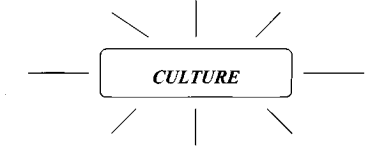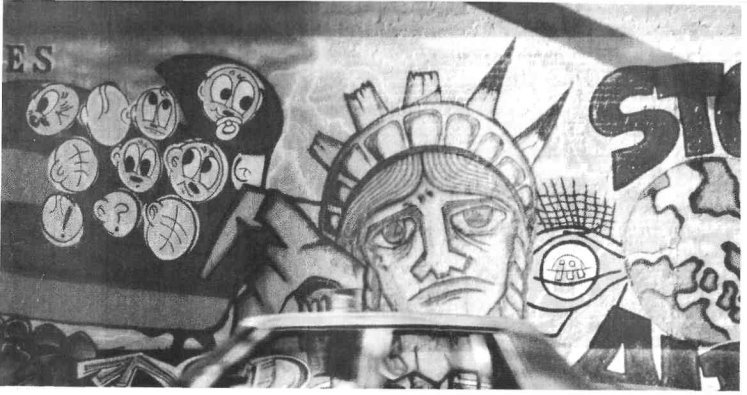Урок на тему " Urban Graffiti: Art or Vandalism?"
Конспект уроку на тему :
Urban graffiti: Art or Vandalism? "
1)г6ап (graffiti: firt or Vandatism? "
Вчитель : Бойко Ірина Ярославівна Чортківська гімназія ім.. М. Шашкевича Тернопільська область
Subject: Modern art. Graffiti as a part of modern art.
Objectives:
• To practise using reading strategies for matching headings and paragraphs.
- To talk about the area where you live.
- To practise using the vocabulary of street entertainment.
- To identify synonyms.
- To practise listening and speaking.
Resources used :
- Magazine " Club" №1 ,2002.
- M. Harris, D.Mower,A. Sikorzynska " Opportunities" upper-intermediate ( Student's book)
- M. Harris, D.Mower,A. Sikorzynska " Opportunities" upper -intermediate (workbook)
- Pictures and photos of the graffiti.

I. Greetings. Today we'll talk about the inseparable part of our life. I mean culture. What is culture for you? Brainstorm ( fill in the spidergram)
(Suggested answers : customs and traditions; arts: music, theatre,
architecture; folklore; ways of behaviour; appearance; etc.)
Now look at these pictures (pupils are shown the pictures of graffiti). Can
we refer it to culture and art? The pupils express their opinions.
Our lesson will be devoted to Graffiti, its history and to the place it takes
in modern life.
II.
1 . Let's travel into the past and find out who gave birth to graffiti. Listen to the text and say what its social history is.
Glossary:
Nickname (n.) - a name which people call you despite the fact that it is not your real name;
deterred (adj.)- afraid to do something in case you are punished;
Andy Warhol -American artist and film maker who was the founder of POP ART;
Keith Haring-American pop artist (died in 1990);
an eye for an eye, a tooth for a tooth - what the Bible says about revenge, if someone takes your eye, you must take theirs; caning/flogging (n.) - hitting someone with a stick /whip;
scruffy (adj.) - dirty, messy, having a bad appearance.
Graffiti is nothing new. The concept is ancient. During the Second World War the phrase 'Kilroy was here' appeared in an amazing variety of places and countries. In 1969 one person in particular made graffiti famous and inspired people to start 'tagging' (writing their nickname in an artistic way). That person was a Greek teenager named Demetrius who lived on 183rd Street in New York. His nickname was Taki so his tag became TAKI 183. He then wrote it everywhere and people copied him. When buses and the subway stopped in the main station in New York, dozens of writers would write their name on it. But it wasn't simply how
many times people could write their name that was important but also the style they did it with.
Graffiti became a way of life - the adrenaline fear of being caught, standing in dangerous places while you graffiti, stealing the paint and creating something they were proud of. Graffiti style was massively influenced by the hip-hop culture that had started in the Bronx in the sixties. Hip-hop with its rapping, breakdancing, attitude and graffiti became a way to show anger and humor. The area and its inhabitants' lives were dominated by crime, drugs, gangs and unemployment. Street gangs began to write the name of their gang on walls in order to mark terroritorial boundaries.
Soon graffiti was spreading across America. In some cases graffiti was literally travelling at 100 miles an hour on trains. The reason railroad and subway trains were so popular for graffiti was so that it could be seen by so many people, from the poorest to the richest neighborhoods. Train companies invested in special cleaning chemicals so that graffiti could be removed quickly. However one graffiti artist in particular was not deterred - Lee Quinones decided if he couldn't paint trains, he'd paint his graffiti on handball courts instead. No graffiti artists had ever been offered money for their work but one day Fred Brathwaite, a graffiti artist himself, offered Quinones money for his murals. Quinones and Braithwaite formed a graffiti mural group. Brathwaite painted a mural on a subway train as a tribute to Andy Warhol's Campbell's Soup cans picture. Soon wealthy gallery owners were noticing the graffiti artists' work. Brathwaite also teamed up with well-respected artist Keith Haring who began doing a lot of his own subway graffiti with chalk. People liked it so much, the subway companies didn't clean it off. Another graffiti artist and Puerto Rican friend of Haring named Jean-Michel Basquiat began to find fame too. Basquiat used to spray messages commenting on religion.
Many graffiti artists from the 1980s became rich. They were criticized for this by others who said that their motivation for graffiti shouldn't be money and that the whole point of graffiti is its 'underground' style. There are also hundreds of international graffiti events for artists now. These events promote unity between graffiti artists who are often rivals (some graffiti or tag over each others' murals.) Political graffiti and stencil graffiti are popular at the moment. 'An eye for an eye leaves the whole world blind' was written on many buildings in New York, as a protest against America's attacks on Afghanistan.
Many states in the USA and different countries would like to stop graffiti. In Pittsburgh USA, there is a proposed law to ban the sale of marker pens to people under 18. Other countries are very harsh. Singapore has just one wall where graffiti can be written (even then, some of it is censored). The
city has a caning for-graffiti rule. In 1994 American teenager Michael Fay spray painted a car and was sentenced to a flogging.
Post-listening activity:
Read the graffiti on the wall below. The graffiti artist was interrupted so he didn't finish his sentences. Match the beginning of the sentences with the endings below:
- Demetrius is a person
- Graffiti style was massively
- Gangs write on walls
- Taggers wrote on trains
- Trains companies bought special chemicals
- Some graffiti artists
- Graffiti events are organized
- Pittsburgh wants to introduce a law
A. that bans the sale of marker pens to the people under 18
B. so that their art could be seen across America
C. were offered a lot of money for their work
D. who made tagging popular.
E. in order to mark their territory.
F. so that graffiti could be removed quickly
G. so that rival graffiti gangs could make friends.
H. influenced by hip-hop culture.
The key: Id; 2h;3e;4b;5f;6c;7g;8a
- Make short summary of the text.
2. Discussion. Define your position and support your choice with
arguments.
The pupils choose the group:
- I am all for it;
- I doubt it's an art, it's vandalism;
- I don't care unless it's not on my apartment building;
The students work in groups discussing arguments to support their position.
Suggested ideas:
- Public property looks scruffy especially when lots of different graffiti crews have competed with each other .
- Graffiti often helps gangs reinforce their territory.
- The public property belongs to the public not just a few graffiti artists and graffiti is expensive to remove.
- Graffiti artists can be creative and provide free new art.
- Freedom of expression is important.
- A lot of graffiti can be an unofficial monument to what is happening in the World, e.g. there is some 9/11 graffiti commemorating the victims,
others voice their worries about the war in Siria.
Express your opinion using the following conversational formulas:
- I see eye to eye with you;
- You've got a point here;
- I couldn't agree more;
- I beg to differ with you;
- You are quite right but...
- Sum up the discussion.
3.Do you think graffiti is widespread in Ukraine/ in our town? Work in pairs discussing your attitude based on the following situations:
- The person drawing graffiti was caught. Talk to him as a representative of the authority;
- Your friend and you have different attitude towards the graffiti. Discuss this form of art;
- A new building in your district is spoilt. Talk with your friend about it.
4. Reading. Let's find out how popular this art in the USA is. Read the text and use the Strategies to match the headings (a-g) with paragraphs 1 -6. There is one extra heading.
- Spoiled Cities
- Transatlantic Success
- Wall Street Art!
- Ghetto Culture
- Tasteless Comics
- Graffiti Products
- Big Change
READING STRATEGIES:
Matching headings and paragraphs
• Read each paragraph carefully. Underline 3-5 of the most important
words.
- Be careful - the first sentence in a paragraph often introduces the main idea - but not always!
- Read the headings and match them with the paragraphs. They often contain a word or a synonym of a word from the paragraph.
- Check that the extra heading does not match any of the paragraphs.
. UNTIL RELATIVELY RECENTLY, GRAFFITI WAS CONSIDERED TO BE AN EXAMPLE OF ANTI-SOCIAL BEHAVIOUR, THE WORK OF VANDALS. NOWADAYS, MANY Of THOSE 'VANDALS' ARE TREATED AS RESPECTED ARTISTS, AND SOME OF THEM HAVE
MADE IT IN THE WORLD OF BUSINESS. SUE CLARKE REPORTS
l.New Yorkers used to see the graffiti on the walls of poor neighbourhoods and subway trains as something menacing and it example of urban decay. The scrawled names and slogans were seen as unsightly and aggressive, the work of vandals seeking to; express their identities or even make a political point. Up to the 1970s, most New Yorkers hated graffiti, considering it as an eyesore that was illegal and punishable by fines.
- Since those days, graffiti has changed a lot and it is no longer found only in the subway and the poor ghetto areas of the city. Nowadays, it has the status of 'street art' and you get graffiti in places where you wouldn't expect to - in advertisements, on clothes, on toys, and even on the Wall Street Journal's official website! In the early 1980s, there was a real craze for graffiti art and the sophisticated Manhattan art world had displays of street art in its galleries. The trend was short-lived - until the arrival of hip-hop music in the late 80s.
- In her book, Subway Art, Martha Cooper says "Graffiti came back with hip-hop music and people are now appreciating it for its style, which they couldn't back then, because they couldn't get beyond the vandalism thing." Hip-hop was originally black ghetto music, sung by young African Americans from the poor, run-down districts of American cities. When it suddenly got to the top of the American music charts, hip-hop culture was spread, bringing graffiti with it.
4. Today companies are starting to realise the appeal of graffiti in
advertising. Kel Rodriguez, who used to spray New York subway trains,
was the artist chosen to design the Wall Street Journal's website and it is
obviously done in graffiti-style. "Some of that graffiti feeling, that
energy, sort of got in there," explained.
5.Many of this new wave of artists give 30 lectures on developments in their art. Lee Quinones is having a lot of success in Europe and feels that European galleries and museums are more open to his art form. "They want to support an artist as he develops," comments Quinones, who can get up to $10,000 for his paintings. Indeed, the Groninger Museum in Holland is one of the few museums in the world that displays and recognises graffiti as an art form.
6.Another artist, Blade, has his own website devoted only to the world of graffiti. This website has a 'merchandise page' where Blade sells things with his own original designs all over the world - everything from baseball caps 45 to yo-yos! Leonard McGurr, a street artist for 25 years, went from painting subway trains to designing and marketing graffiti-inspired clothes for young people. "Graffiti has been a story of survival," he says. "There's a way to benefit from your work without spoiling public property."
KEY: la; 2g; 3d; 4c; 5b; 6f;
Post-reading activity:
- Find synonyms in the text for these words and expressions. Paragraph
numbers are in brackets.
1 .threatening (1)
2.ugly(l)
3.fad(2)
4.classy (2)
5.damage to property (3)
6.depressed area (3)
7.receptive (5)
8.acknowledges (5)
9.products (6)
10.advertising and selling (6)
Key: 1 menacing 2 unsightly 3 craze 4 sophisticated 5 vandalism
6 run-down 7 open 8 recognises 9 merchandise 10 marketing
- Answer these questions about the text.
- Why did New Yorkers consider graffiti the work of vandals?
- Why did graffiti artists suddenly become respectable in New York?
- What influence did music have on the popularity of graffiti artists?
4 In what way does Europe take graffiti art more seriously than the
USA?
5 How do some graffiti artists make money?
4. Write a paragraph about the street art you see or hear in your town or area.
III. Home assignment. Write your ideas if graffiti has to be banned or has the right to exist. How can we prevent the spoiling of public property?



про публікацію авторської розробки
Додати розробку
